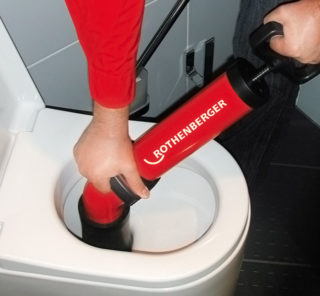Washing vegetables and fruits in the kitchen sink, cleaning shoes in the bathroom above the washbasin, draining water and hair, and many other actions cause clogging of sewer pipes. Everyone faced this problem in everyday life. Most often, plumbing is entrusted to repair, but using a conventional plunger you can fix the situation yourself, saving time and money.
Plunger and its types
Most likely, there is no such person who would not have seen this instrument in life. Parents usually hide him in the toilet behind the toilet or in special closets. With the help of this device in the water supply, air congestion was eliminated by plumbers of the 19th century. Today, the plunger is presented in various forms and modifications, but this does not affect its principle of operation. Masters use pneumatic, vacuum or mechanical plungers.
Mechanical
 The tool is a plastic or wooden handle with a conical or bowl-shaped nozzle made of rubber planted at one end. The appliance leans against the outlet of the pipe with the hollow part. By means of rhythmic pressure, pressure is applied to its handle, creating a hydraulic shock in the pipe. Thus, the water itself destroys the formed lump of garbage, removing it back or pushing further along the drain.
The tool is a plastic or wooden handle with a conical or bowl-shaped nozzle made of rubber planted at one end. The appliance leans against the outlet of the pipe with the hollow part. By means of rhythmic pressure, pressure is applied to its handle, creating a hydraulic shock in the pipe. Thus, the water itself destroys the formed lump of garbage, removing it back or pushing further along the drain.
Depending on the task that needs to be performed to clean the pipes, mechanical plungers are divided into:
- ordinary or classic - they cope with standard, located near the drain, sections of water obstruction;
- conical rubber - the elastic valve is pressed closer to the walls of the hole, creating a stronger liquefaction when pressed. This increases the effect of the water column on blockage.
In addition to accessibility for the average consumer, mechanical plungers are easy to use and do not require special knowledge or skills.
Vacuum
It has a simple design and an easy to use vacuum plunger, instead of putting pressure on the accumulated rubbish bin, it extracts it outward by creating a dilution in the flask. Externally, the vacuum tool is similar to a large plastic syringe with a tightly set rubber tip instead of a needle.
Pneumatic
 Such a tool relates to professional equipment, is highly efficient and therefore cost. In appearance, the pneumatic plunger is more like something in between a pump and a gun with a rubber nozzle at the end. Inside the product there is a cavity with a volume of up to 2 liters, which before operation is filled with air, compressing to the desired pressure level. After tightly fixing the tool bowl to the neck of the drain, this air shoots out like a weapon. A sharp expansion of gas in the cavity between the valve of the tool and the neck of the drain creates a strong blow, pushing the blockage.
Such a tool relates to professional equipment, is highly efficient and therefore cost. In appearance, the pneumatic plunger is more like something in between a pump and a gun with a rubber nozzle at the end. Inside the product there is a cavity with a volume of up to 2 liters, which before operation is filled with air, compressing to the desired pressure level. After tightly fixing the tool bowl to the neck of the drain, this air shoots out like a weapon. A sharp expansion of gas in the cavity between the valve of the tool and the neck of the drain creates a strong blow, pushing the blockage.
Depending on the type of drain hole, professional plungers are:
- for a kitchen sink or washbasin in the bathroom - round rubber nozzles of different diameters are used to contact the pipe outlet cavity or the plane of the sink, bathtub;
- for the toilet - most often a curved wide nozzle comes in a complete set with the tool. It just tightly enters the drain, blocking the water outlet from it.
On the market you can find pneumatic and vacuum plungers in this configuration:
- with one flexible wide nozzle for cleaning shower drains, bath drains and showers;
- with one rubber nozzle that can rotate in different directions, which greatly facilitates the introduction of the device into the drain channel for a more effective effect on the blockage;
- with 2 or more round elastic removable nozzles for various tasks, including the possibility of cleaning the toilet;
- with large valves for the urinal, toilet, bidet;
- with adapters for bathtubs and sinks - for different diameters of drain holes - professional kits are available. The case of such a tool is made from impact-resistant plastic, which makes it expensive, but durable and reliable.
Rubber nozzles are needed to create a hermetic connection between the cavity of the device and the pipe. Any leak will significantly reduce the pressure and will not bring the desired effect.
Principle of operation
 Regardless of the value of the tool, its work is based on the fundamental laws of physics. Conventional running water is known to have the least compressibility. In other words, if a column of water is pressed with another column of the same liquid in a closed pipe, then it will not decrease in volume, but will transmit pressure throughout the cavity of the tank. The denser the container is closed, the less is the loss of effort that is transmitted through water hammer.
Regardless of the value of the tool, its work is based on the fundamental laws of physics. Conventional running water is known to have the least compressibility. In other words, if a column of water is pressed with another column of the same liquid in a closed pipe, then it will not decrease in volume, but will transmit pressure throughout the cavity of the tank. The denser the container is closed, the less is the loss of effort that is transmitted through water hammer.
The method of using these physical properties of water determines the type of plunger:
- A mechanical tool requires a water level in the container above the drain, which will fill the bowl or cone completely;
- Vacuum device with the help of an empty internal cavity and extension of the piston-handle creates a dilution in the area from blockage to the walls of the tank;
- The pneumatic mechanism uses air, which then, after tightly pressing the nozzle against the drain, shoots into the pipe.
Most of all sewage is formed around the drain after applying vacuum plungers. This should be considered when choosing a tool for unlocking sewage pipes. The most “accurate” device is pneumatic, because its operation is based on pushing the blockage further down the pipes.
Step-by-step algorithm for clearing a blockage in pipes using a plunger
 Regardless of what type of plunger is selected, it is necessary to track all the drains available in the apartment that go to the common drain pipe, including overflows in the bathroom or shower, etc. Seal with a thick cloth dampened with water. This will prevent pressure leakage.
Regardless of what type of plunger is selected, it is necessary to track all the drains available in the apartment that go to the common drain pipe, including overflows in the bathroom or shower, etc. Seal with a thick cloth dampened with water. This will prevent pressure leakage.
If possible, clean the plumbing from excess debris and liquid, leaving a little water to create a column of pressure on the blockage. Also, a container with clean water will not interfere to verify the effectiveness of the measures taken.
Instructions for using a mechanical plunger:
- Install the plunger tightly around the drain so that fluid enters its cavity.
- Alternately, sharply push and just as quickly pull the plunger back. This will create the necessary vibrations of the water column, swinging the mud ball. The appearance of particles of garbage will indicate the correct execution of actions.
- The procedure must be repeated until the water drains at the same rate into the sewer.
Instructions for using a vacuum plunger:
- Collect clean water and a maximum mark into the cavity of the “syringe”.
- Connect the nozzle firmly to the drain so that the tool stops evenly.
- With maximum force, sharply lower the handle.
- Repeat several times as necessary. Usually, after 2-3 procedures, the blockage is destroyed.
- Pour clean water to check and track the rate of its discharge into the sewer. If the rate of decrease in liquid level in the sink or bath is lower than usual, repeat the procedure several more times until the desired result is achieved.
Instructions for using a pneumatic plunger:
- Connect a portable or network device to the power supply.
- Select and install the necessary rubber nozzle.
- Select the desired pressure level in the settings and press the button to start pumping it.
- Make sure that the device is ready for use (does not emit extraneous sounds, clicks, the value of the working pressure is fixed on the scale).
- Press the rubber nozzle firmly against the drain and press the start button. Air should shoot under pressure up to 10 atm.
- Check the effectiveness of the procedure by pouring clean water into the sink, bathroom or toilet. Check fluid drain rate.
To fix the cleaning effect, rinse the drain with hot water, fill in the chemical cleavage blocker according to the instructions of the product.
Nuances and tips for use
 To successfully get rid of clogging in sewer pipes, the following points must be considered:
To successfully get rid of clogging in sewer pipes, the following points must be considered:
- It is first necessary to assess the degree of severity and the most likely causes of sewage obstruction. If before the blockage there was a hit of large materials, garbage, food waste and similar objects, then you can try to deal with obstruction yourself. If in doubt, but there are no obvious reasons, then it is better to use the help of specialists so as not to harm even more.
- You need to understand that the work of plumbing is necessarily associated with unpleasant odors, terrible waste and other unaesthetic things. If there is no desire to face the world of sewage, a plumber is simply irreplaceable.
- To clean, you need to protect your hands and face. It is best to wear high tight rubber gloves and a closed-type plastic mask. An apron and a respirator will not hurt, but this is not necessary.
- After all the procedures, you need to wash your hands thoroughly with household or antibacterial soap, change clothes.
- If the plunger valve does not fit tightly, then applying a small layer of petroleum jelly or oily cream will help to fix this.
- If a nozzle flies from a mechanical tool, then it can be attached to a wooden or rubber handle with screws or nails. Just choose them should not be very large in diameter, so as not to split the stalk.
- An unsuccessful outcome after numerous attempts indicates either the mistakes made or the deep location of the blockage. In any case, you need help from the wizard.


